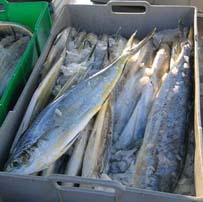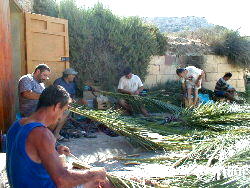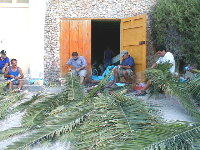
J. Pullicino
 One of the most awaited fishing seasons by local fishermen is the lampuki season known as Kannizzati Fishing. During this season'larnpuki' (dolphin fish) and 'fanfri' (pilot fish) are caught in large quantities. In fact, during 1987 a record amount of these two species was landed, of which a considerable part, was exported. One of the most awaited fishing seasons by local fishermen is the lampuki season known as Kannizzati Fishing. During this season'larnpuki' (dolphin fish) and 'fanfri' (pilot fish) are caught in large quantities. In fact, during 1987 a record amount of these two species was landed, of which a considerable part, was exported.
Little is known about the migratory and spawning habits of either lampuki or fanfri. What is certain is that by mid-August they appear in Maltese waters and by December they disappear. The lampuki and fanfri seek shelter under any floating object in the sea.
Each year the Fisheries Department receives around 120 applications from full-time and part-time fishermen to lay kannizzati floats, By drawing lots each fishermen is allotted a site to lay floats on a bearing point, thus preventing disputes in the laying of floats.
The first float is laid about seven miles offshore by officials from the Fisheries Department. When this is laid, fishermen continue to extend seawards the number of floats they consider adequate. Some  fishermen lay up to 300 floats on their respective site, the distance varying from one float to another, The distances between one float and another get closer the further offshore they are laid. fishermen lay up to 300 floats on their respective site, the distance varying from one float to another, The distances between one float and another get closer the further offshore they are laid.
Once the lampuki and fanfri find a float they take shelter underneath it for week, or even months before they migrate again. The float, known locally as the kannizzata, consists of a tubular mass of cork, several layers thick, which are bound together by means of polyethylene rope. Nowadays fishermen are finding it more economical to use gable instead of cork. To each float is attached a marker flag together with a battery lamp to make it visible at night.
The float is anchored to a heavy stone slab by means of polyethylene rope. Just under sea level, palm fronds are tied to the rope to afford more shelter to the fish. It has been found that these fronds produce a kind of sea worm when under water, on which lampuki and fanfri seem to thrive The depth to which these floats are anchored varies from 100 to 800 metres which may be even deeper in some areas.
The net used for this kind of fishing may be called a purseseine, but without the use of pursing rings. Each operating fishing vessel uses a different size of this kind of net depending on the length of the vessel. Each net consists of two wings, mesh size 25mm, the centre of the net known as 'Font', mesh size 22mm, and the landing bags, mesh size 16mm. Synthetic floats and lead are tied to the top and bottom of the net respectively. The material of which these nets are made 'is nylon.
When fishing for lampuki and fanfri, the sea has to be as calm as possible. Larger vessels stay out longer at sea than smaller ones. When fishermen approach the anchored floats, first they have to be sure of the presence of fish underneath them.
Seeing that it is viable to cast the net, the vessel circles slowly around the floats laying the net as it proceeds. When the two wings of the net meet, these are hauled on board the vessel so that the fish caught inside are concentrated in a small area of the net. The float is slipped between the bottom of the net, which is now closed, but for a narrow slit between the lead line. The bottom ropes of the net are then hauled on to the vessel by means of a hydraulic winch thus confining the fish in the landing bag. The time taken for such an operation is less than 10 minutes when professionals do such fishing. This procedure is repeated every time the fishermen detect the presence of a considerable amount of fish under a float.
 It is the custom for fishermen from the fishing village of Marsaxlokk to gather in port at the start of the lampuki season and have their vessels blessed by the parish priest. It is the custom for fishermen from the fishing village of Marsaxlokk to gather in port at the start of the lampuki season and have their vessels blessed by the parish priest.
One might ask what other kind of fish are caught by local fishermen in the other months of the year, Fishing for swordfish and tuna has nowadays a considerable amount is being exported to Italy, Japan, West Germany and the United Kingdom.
The season for the fishing of swordfish and tuna is from April to August and recently some fishermen have opted to continue fishing for these species up to December preferring to do this than engage themselves in fishing for lampuki and fanfri. The method used in fishing for swordfish and tuna is by means of long lines which sometimes extend to 50 kilometres. Frozen mackerel is used as bait.
Between December and March fishermen switch over to fishing by means of bottom ling lines. The main species caught during this period are stone bass, dogfish and ray. During the same period, a few fishermen, especially Gozitans, fish by means of pots (nasses) in which bogue and scad are caught.
The type of fishing carried out throughout the year is trawling. The trawler fleet of these islands consists of only 10 vessels. Species caught during trawling operations are shrimps, king prawn, bream, red mullet, octopus and other types found on trawling grounds.
As can be seen quite a number of species of fish are landed by local fishermen through the year. This proves that Maltese and Gozitan fishermen can adapt themselves to any type of fishing and easily switch over from one fishing season to another. Nowadays local fishermen are acquiring modern vessels equipped with the latest navigational and fishing equipment found on the market, thus having more time for fishing and reaching far - off fishing grounds.
Now for some 'lampuki' recipes:
Lampuki Fritters
Ingredients
garlic
mint
oil for frying
flour
seasoning
For the batter
250ml milk
200g flour
10g yeast
salt
Method
1 Clean the fish and fillet cutting into small pieces.
2 In a small bowl marinate fish in chopped garlic, olive oil, mint and seasoning. Leave for 2 hours.
3 Prepare the batter by mixing the flour, salt and yeast. All lukewarm milk, stir and leave to set in a warm place for 1 hour.
4 Remove the fish from the marinate, pass through the flour, batter and fry in plenty of hot oil till golden brown.
5 Serve hot with tomato sauce.
This dish is ideal for cocktail parties.
Baked Lampuki
Ingredients
lampuki
olive oil
4 medium sized lampuki
40g peeled onions
3/4kg peeled potatoes
little water
fennel seeds
marjoram
garlic
oil
seasoning
Method
1 Clean and wash the fish. Cut the potatoes and onions into thick slices. Peel the garlic. Prepare a baking dish with a layer of potatoes and onions.
2 Put the fish one near the other on this bed of potatoes and onions. Crush garlic on the fish, season and sprinkle some marjoram. Cover with the remainder of potatoes and onions, season and sprinkle some fennel seeds.
3 Put some oil and water on the fish and bake in a moderate oven for at least 90 minutes.
Lampuki with Caper Sauce
Ingredients
1kg lampuki
500g peeled tomatoes
25g tomato paste
200g peeled onions
150g capers
flour
olive oil
mint
garlic
lemon zest
seasoning
Method
1 Clean the fish, remove head and tail. Cut into small pieces, about 8cm long. Pass through seasoned flour and fry on both sides in hot olive oil. Cook till done.
2 Fry the onions and garlic in a little oil till golden colour, add the tomatoes and tomato paste, simmer for 10 minutes. Add the capers, lemon zest, mint and seasoning. Continue simmering for 10 minutes.
3 Put the fish in a serving dish, cover with the sauce, continue cooking for a further 5 minutes. Serve hot.
Lampuki with Green Pepper Sauce
Ingredients
1kg lampuki
1/2kg peeled tomatoes
200g chopped onions
1/2kg green pepper
25g tomato paste
olive oil
mint
garlic
flour
lemon zest
seasoning
Method
1 Clean the fish, remove head and tail. Cut into small pieces, about 8cm long. Pass through seasoned flour and fry on both sides in hot olive oil. Cook till done.
2 Clean and roughly slice the green pepper. Fry in a little oil till crisp.
3 In a separate pan fry the onions and garlic, add the mint, tomatoes and tomato paste. Simmer for 15 minutes. Add the finely chopped zest and seasoning. Add this sauce to the fried green pepper.
4 Put the fish into the sauce and cook in the oven for 20 minutes. Serve hot.
Lampuki Pie
Ingredients
750g lampuki
250g peeled and chopped tomatoes
250g boiled cauliflower
250g tomato pureè
200g chopped onions
150g peas
100g black olives
200g cooked spinach
2 eggs
olive oil
fresh mint
lemon zest
garlic
sesame seeds
salt and pepper
short or puff pastry
Method
1 Clean the fish and steam or boil. Leave to cool and remove all bones.
2 Heat some oil, fry the onions and garlic and cook to a light golden colour. Add the peas, chopped cauliflower, spinach, olives, tomatoes, tomato paste, zest of lemon, salt, pepper and mint. Cook for a few minutes. Add the eggs.
3 Line a greased pie dish with pastry. Fill in with the lampuki mixture. Moisten the edges and cover with pastry. Egg wash.. Sprinkle some sesame and cook in a moderate to hot oven for 50 minutes.
| 
